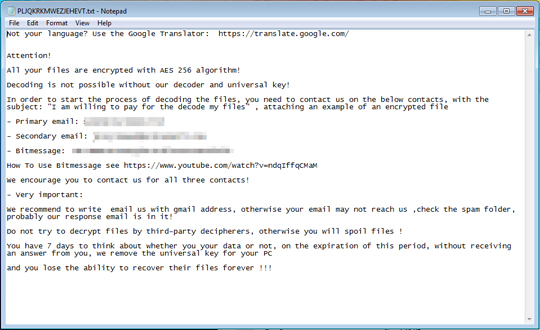RANSOM_JUSINOMEL.A
Ransom:Win32/CryptoLemPiz.A (Microsoft), Win32:Ransom-AYY [Trj] (Avast)
Windows


Threat Type: Trojan
Destructiveness: No
Encrypted: Yes
In the wild: Yes
OVERVIEW
Downloaded from the Internet
This Trojan arrives on a system as a file dropped by other malware or as a file downloaded unknowingly by users when visiting malicious sites.
It connects to certain websites to send and receive information. It deletes itself after execution.
TECHNICAL DETAILS
110,714 bytes
EXE
No
20 Jul 2016
Displays message/message boxes, Encrypts files, Connects to URLs/IPs
Arrival Details
This Trojan arrives on a system as a file dropped by other malware or as a file downloaded unknowingly by users when visiting malicious sites.
Installation
This Trojan drops the following files:
- {malware path}\PLJQKRKMWEZJEHEVT.txt - Serves as ransom note
- {folders containing encrypted files}\README NOW !!!.txt - Serves as ransom note
It adds the following mutexes to ensure that only one of its copies runs at any one time:
- WrXehWMqEUv9ObHQ
Autostart Technique
This Trojan adds the following registry entries to enable its automatic execution at every system startup:
HKEY_CURRENT_USER\Software\Microsoft\
Windows\CurrentVersion\Run
WrXehWMqEUv9ObHQ = "{malware path}\{malware filename}.exe"
Other System Modifications
This Trojan adds the following registry keys:
HKEY_LOCAL_MACHINE\SOFTWARE\WrXehWMqEUv9ObHQ
It adds the following registry entries:
HKEY_LOCAL_MACHINE\SOFTWARE\WrXehWMqEUv9ObHQ
WrXehWMqEUv9ObHQu = "Ee-{random characters)"
HKEY_LOCAL_MACHINE\SOFTWARE\WrXehWMqEUv9ObHQ
WrXehWMqEUv9ObHQp = "{random characters}"
HKEY_LOCAL_MACHINE\SOFTWARE\WrXehWMqEUv9ObHQ
WrXehWMqEUv9ObHQs = "1"
It modifies the following registry entries:
HKEY_LOCAL_MACHINE\SYSTEM\CurrentControlSet\
services\VSS\Diag\
SPP
SppEnumGroups (Enter) = {hex values}
HKEY_LOCAL_MACHINE\SYSTEM\CurrentControlSet\
services\VSS\Diag\
SPP
SppEnumGroups (Leave) = {hex values}
HKEY_LOCAL_MACHINE\SYSTEM\CurrentControlSet\
services\VSS\Diag\
SPP
SppGetSnapshots (Enter) = {hex values}
HKEY_LOCAL_MACHINE\SYSTEM\CurrentControlSet\
services\VSS\Diag\
SP
SppGetSnapshots (Leave) = {hex values}
Other Details
This Trojan connects to the following website to send and receive information:
- http://{BLOCKED}veforyou.com/456/index.php
It renames encrypted files using the following names:
- {filename of encrypted file}.{extension of encrypted file}.id-{unique ID per victim}_sos@juicylemon.biz
It deletes itself after execution.
NOTES:
This ransomware encrypts files in the affected system.
It avoids encrypting files in folders and subfolders with names that start with any of the following strings:
- windows
- program
It avoids encrypting the following files:
- boot.ini
- NTDETECT.COM
- Bootfont.bin
- ntldr
- bootmgr
- BOOTNXT
- BOOTSECT.BAK
- NTUSER.DAT
- PDOXUSRS.NET
It avoids encrypting files with the following extensions:
- .acm
- .ade
- .adp
- .app
- .asa
- .asp
- .aspx
- .ax
- .bas
- .bat
- .bin
- .biz
- .bootmgr
- .chm
- .clb
- .cmd
- .cnt
- .cnv
- .com
- .cpl
- .cpx
- .crt
- .csh
- .dll
- .drv
- .dtd
- .exe
- .fxp
- .grp
- .h1s
- .hlp
- .hta
- .ini
- .ime
- .inf
- .ins
- .isp
- .its
- .js
- .jse
- .ksh
- .lnk
- .mad
- .maf
- .mag
- .mam
- .man
- .maq
- .mar
- .mas
- .mat
- .mau
- .mav
- .maw
- .mda
- .mdb
- .mde
- .mdt
- .mdw
- .mdz
- .msc
- .msi
- .msp
- .mst
- .mui
- .nls
- .ntldr
- .ocx
- .ops
- .pal
- .pcd
- .pif
- .prf
- .prg
- .pst
- .reg
- .scf
- .scr
- .sca
- .sys
It terminates itself if it is found running in the Virtual Box.
It deletes shadow copies.
It displays the following ransom note:

SOLUTION
9.800
12.664.03
20 Jul 2016
12.665.00
21 Jul 2016
Step 1
Before doing any scans, Windows XP, Windows Vista, and Windows 7 users must disable System Restore to allow full scanning of their computers.
Step 2
Note that not all files, folders, and registry keys and entries are installed on your computer during this malware's/spyware's/grayware's execution. This may be due to incomplete installation or other operating system conditions. If you do not find the same files/folders/registry information, please proceed to the next step.
Step 3
Delete this registry key
Important: Editing the Windows Registry incorrectly can lead to irreversible system malfunction. Please do this step only if you know how or you can ask assistance from your system administrator. Else, check this Microsoft article first before modifying your computer's registry.
- In HKEY_LOCAL_MACHINE\SOFTWARE
- WrXehWMqEUv9ObHQ
- WrXehWMqEUv9ObHQ
Step 4
Delete this registry value
Important: Editing the Windows Registry incorrectly can lead to irreversible system malfunction. Please do this step only if you know how or you can ask assistance from your system administrator. Else, check this Microsoft article first before modifying your computer's registry.
- In HKEY_CURRENT_USER\Software\Microsoft\Windows\CurrentVersion\Run
- WrXehWMqEUv9ObHQ = "{malware path}\{malware filename}.exe"
- WrXehWMqEUv9ObHQ = "{malware path}\{malware filename}.exe"
Step 5
Search and delete these files
- {malware path}\PLJQKRKMWEZJEHEVT.txt
- {folders containing encrypted files}\README NOW !!!.txt
Step 6
Scan your computer with your Trend Micro product to delete files detected as RANSOM_JUSINOMEL.A. If the detected files have already been cleaned, deleted, or quarantined by your Trend Micro product, no further step is required. You may opt to simply delete the quarantined files. Please check this Knowledge Base page for more information.
Step 7
Restore encrypted files from backup.
Did this description help? Tell us how we did.

